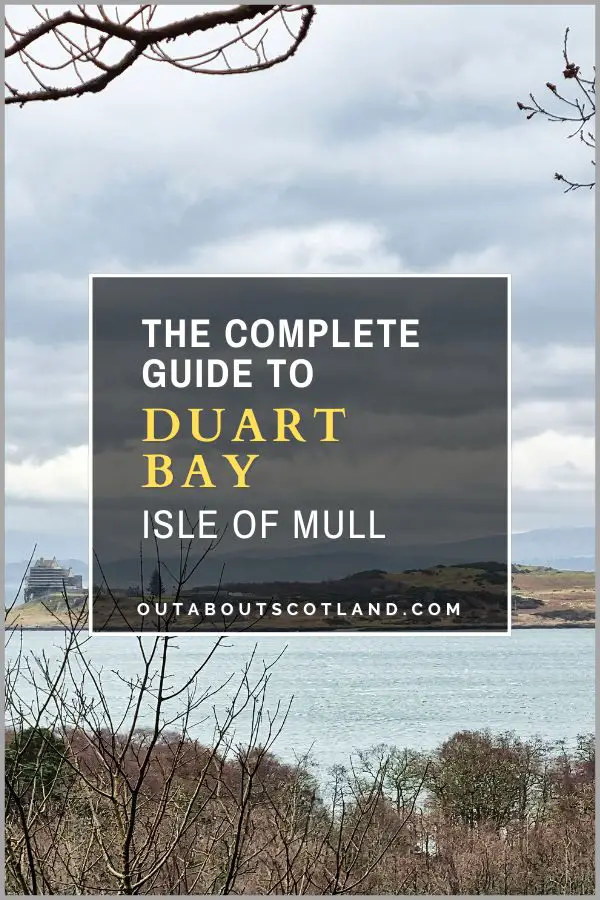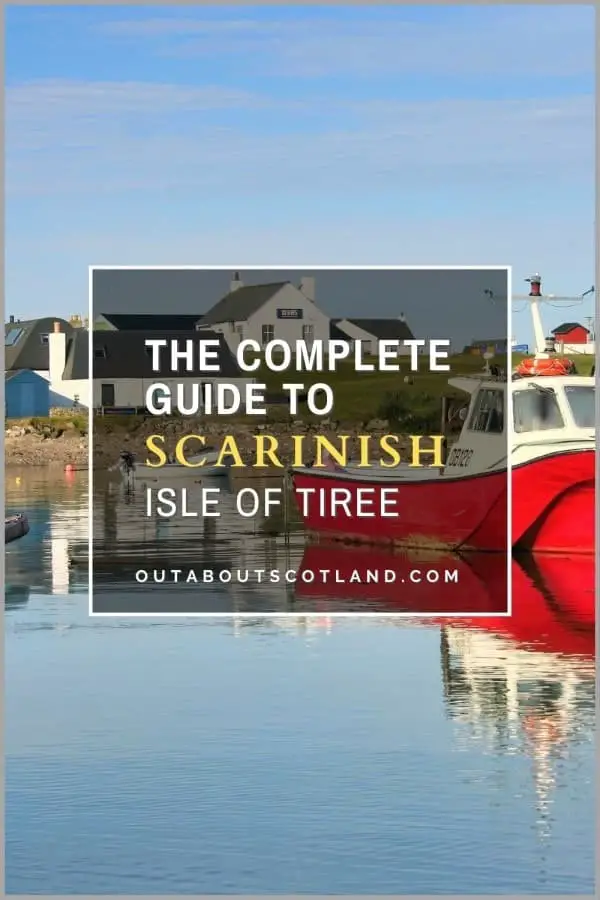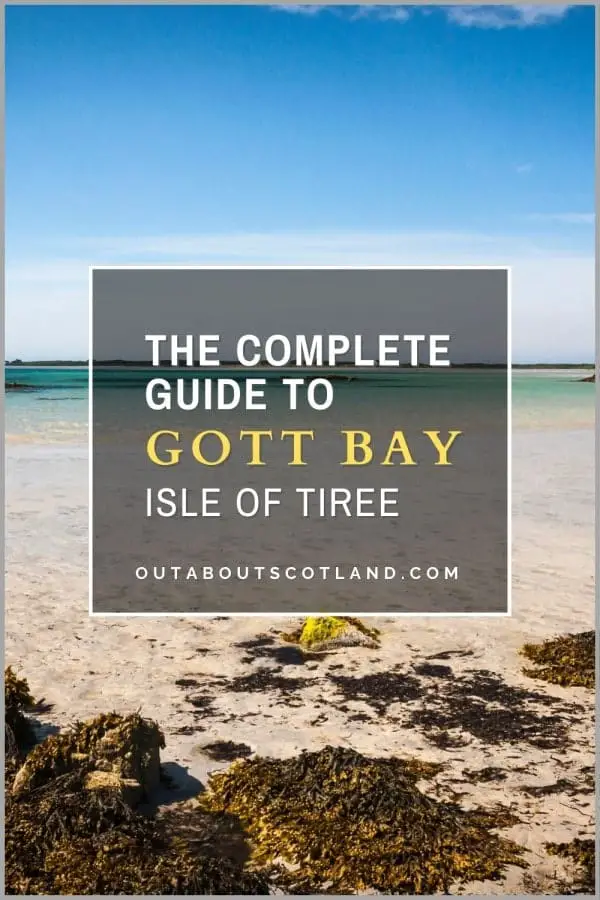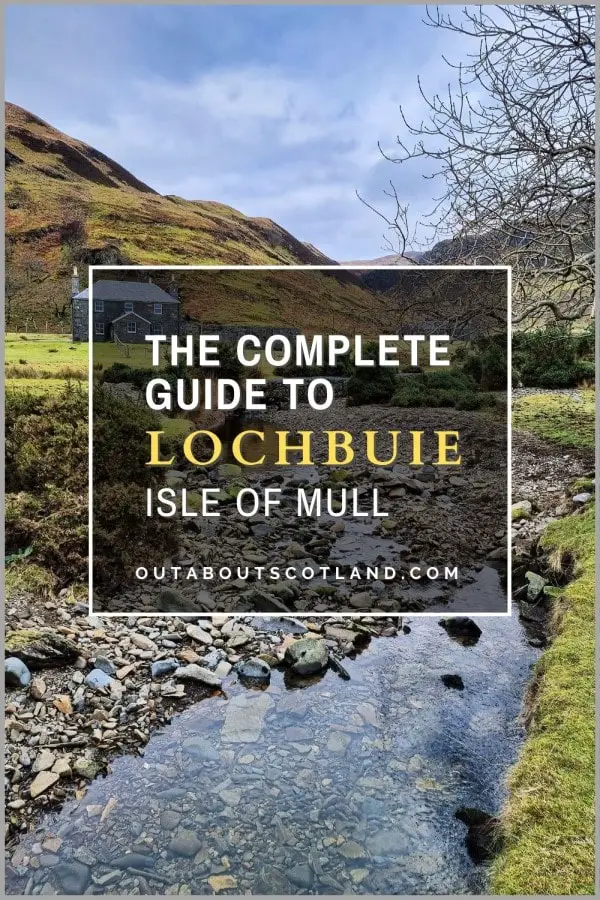The Isle of Coll, part of the Inner Hebrides, lies on the edge of Scotland’s west coast, directly north of Tiree and west of Mull. This stunning island is surrounded by miles of pristine golden beaches and has vast swathes of unspoilt countryside at its centre. Coll is also pleasingly free of tourism, making a visit to this gem of an island a real step back in time. Explore and discover Coll in this complete guide, which includes an overview and visiting advice.
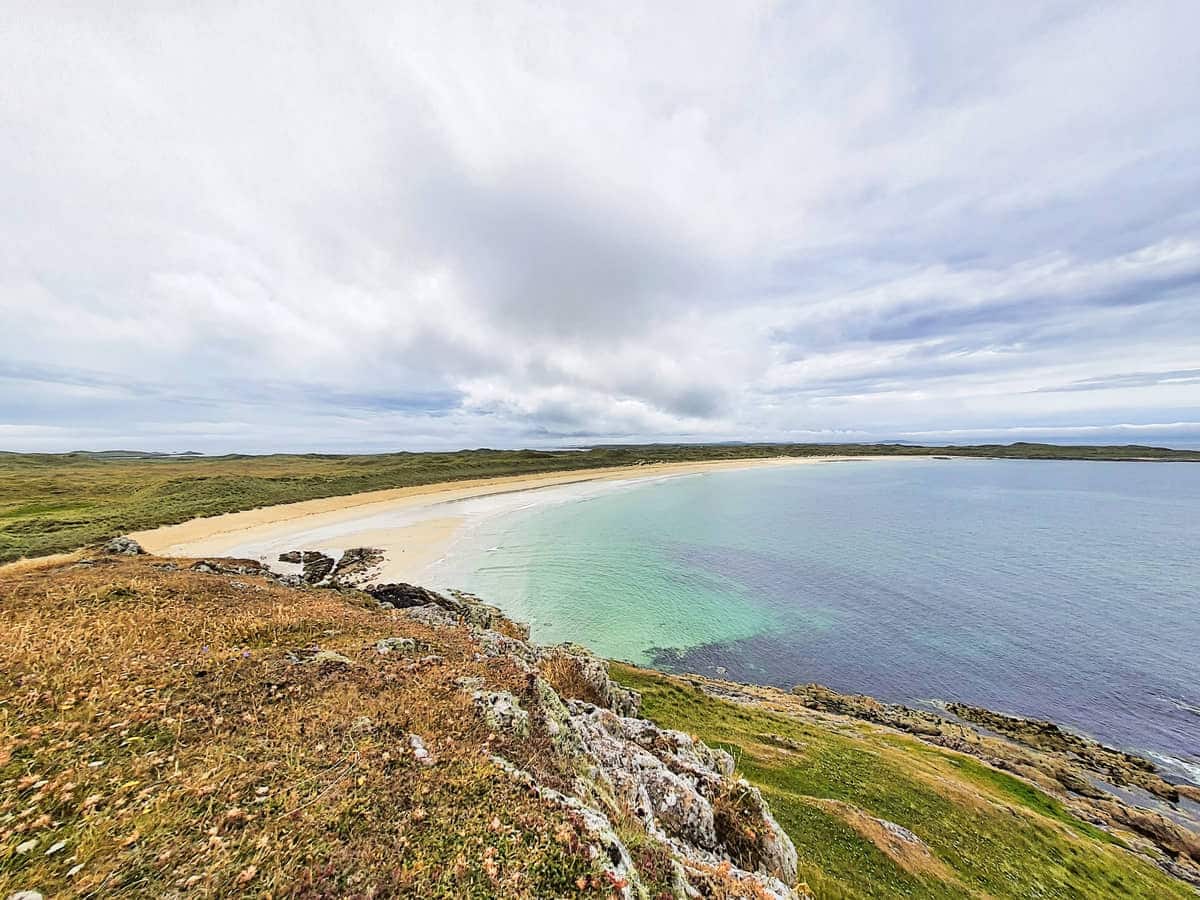
Overview
For the last five years, myself and my other half have spent at least one week each summer on the Inner Hebrides Isle of Tiree, where we’ve thoroughly enjoyed its relaxed atmosphere and beautiful beaches.
One of my favourite Tiree beaches (click the link to see my guide) is Caolas on the northern tip, which has spectacular views of the tiny island of Gunna and the much larger Isle of Coll. Coll was always a mystery to me, and I’ve yearned to explore it ever since I first caught sight of it, which is why I made a point of booking an overnight stay during a recent break on Tiree.
If you’re not sure where Coll is, it’s basically immediately west of Mull and north of Tiree on Scotland’s west coast. To get to the island, visitors have two options: Hebridean Air from Tiree and Oban, or the more accessible (and usually cheaper) Calmac ferry sailings from Tiree and Oban.
Journey times to Coll by ferry are around two to three hours from Oban and just under one hour from Tiree, making the latter the preferred option for brief overnight stays.
The ferry terminal is located midway on the eastern side of the island, a mile or so from the largest settlement of Arinagour. There’s not much at the terminal other than a waiting room and a car park, so from there I suggest heading straight to the village. There are only 200 permanent residents on the entire island, so, as you might expect, Arinagour is rather small, though it does have an excellent hotel, a café, and a wee shop.
The café is very good, but the highlight is the Coll Hotel which has a surprisingly good restaurant with panoramic windows as well as an outside seating area that looks over the picturesque Loch Eatharna.
There are basically two directions to take from Arinagour: the B8070 heading south or the B8071 heading north, but if you’re on the island purely to go sightseeing, you may as well toss a coin as both directions are equally scenic.
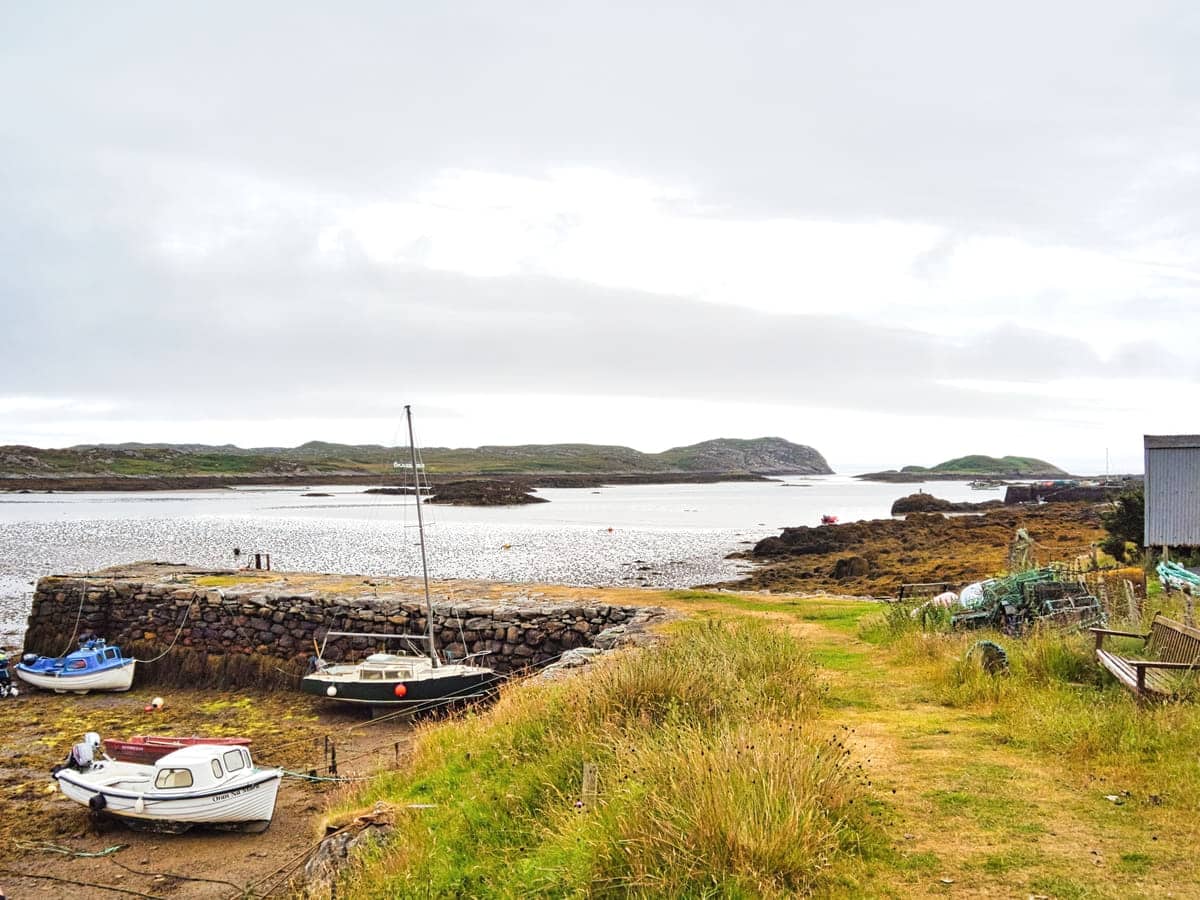
Both the north and south sides of Coll are predominantly heather- and wildflower-covered moorland, which is almost entirely free of human habitation. It’s slightly more hilly than Tiree, with large areas of undulating hills,especially on the northern side, and the landscape is pockmarked with dozens of pretty lochs and lochans.
This rough terrain appears to be the main reason why there’s only a single road on the northern half of the island which threads its way along the western edge, leaving visitors with no option but to hike across the eastern side.
The southern half of Coll, meanwhile, fares slightly better as far as roads go as there’s almost a complete ring road which ends between the RSPB car park at Totronald and Loch Ballyhaugh (check Google Maps to find these locations), so a complete touring circuit is tantalizingly close but sadly impossible.
Note that the roads on Coll are single-track but are in good condition so cycling around them shouldn’t pose any issues, although once you leave the tarmac the tracks become rather rough, meaning anything other than a mountain bike will struggle.
Size-wise, Coll is a small island, measuring a mere thirteen miles in length and three miles in width, so a car isn’t really necessary to explore it. In fact, I only used pedal power for the two days I was on the island and I still managed to see most of it.
The one thing you might struggle with on Coll is finding accommodation, as there aren’t many options and they all book up early in the year. However, as far as location goes you might consider doing what I did and book a room in Arinagour as it’s situated halfway up the island which makes it an ideal base for exploring.
I stayed at the Coll Bunkhouse which has purpose-built rooms with separate, individual bathroom facilities. The price was great, and the facilities are excellent, with a large kitchen/dining room, ample car parking, and bike storage. It’s also just a five-minute walk to the local shop and the Coll Hotel.
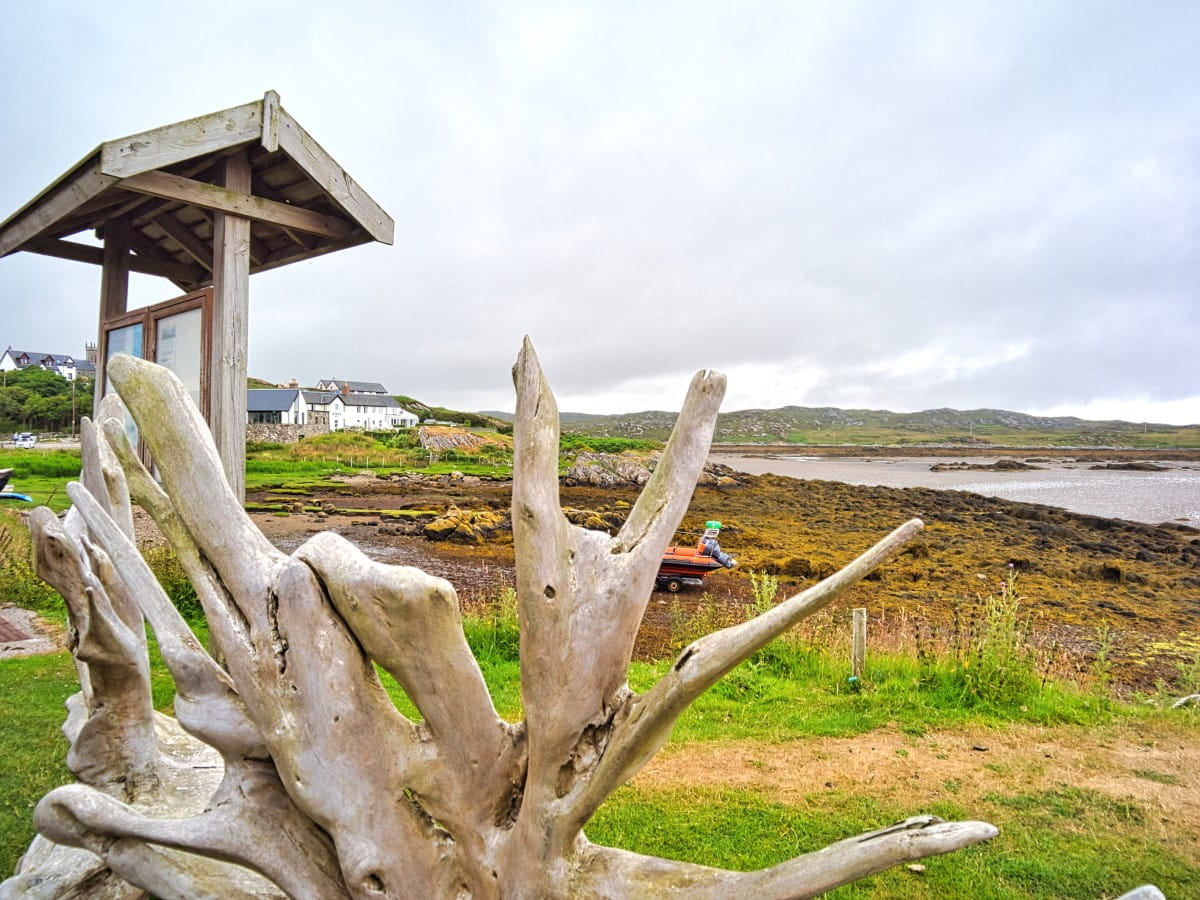
The Highlights
1: The scenery on the Isle of Coll is really quite beautiful. Not quite up to Skye’s standards admittedly, but very, very pretty nonetheless. Perhaps the nicest part of the island is the northern half which is wild, desolate, and perfect for escaping from the hustle and bustle of modern life.
2: Due to Coll having so few people living on it, it’s one of the best places in Scotland for viewing the night sky away from light pollution. Visiting Coll at night guarantees uninterrupted vistas where the Milky Way can be seen in all its glory, and in fact, Coll is one of the few official Dark-Sky Communities in Scotland.
3: There aren’t many places to dine on Coll so it’s just as well the Coll Hotel – located on the shore of Loch Eatherna in Arinagour – is so good. The recently renovated hotel offers overnight accommodation with 10 spacious rooms and an award-winning restaurant that serves a variety of dishes including scrumptious creel-caught lobster.
There’s also a well-stocked bar and a garden area for alfresco dining with gorgeous views of the loch. Top tip: ask for a gin from the local Isle of Coll distillery if you visit the bar – it’s delicious.
Visiting Tips
1: If you’re planning to visit Coll in the warmer months I guarantee you’ll have a fantastic time if you wild camp. Coll has lots of places where you can pitch a tent, but I personally recommend the beach on the southernmost edge of the island, which has amazing views of the isles of Gunna and Tiree. Be sure to read the Scottish Outdoor Access Code before pitching your tent.
2: Although it’s possible to access the island by air (see Hebridean Air for details) most people choose to take the Isle of Coll ferry. The sail from Oban to Coll takes around two and a half hours, or visitors can sail from Tiree which takes just under one hour. See the Caledonian MacBrayne website for further details.
3: No matter the time of year, Coll’s beaches are a pleasure to walk along. There are more than thirty on this small island but most of them involve a short walk to get to, which in turn ensures they’re rarely visited. Don’t be surprised to visit some of Coll’s beaches in the middle of summer and find you’re the only person there! Discover the location of Coll’s beaches at the official Visit Coll website.
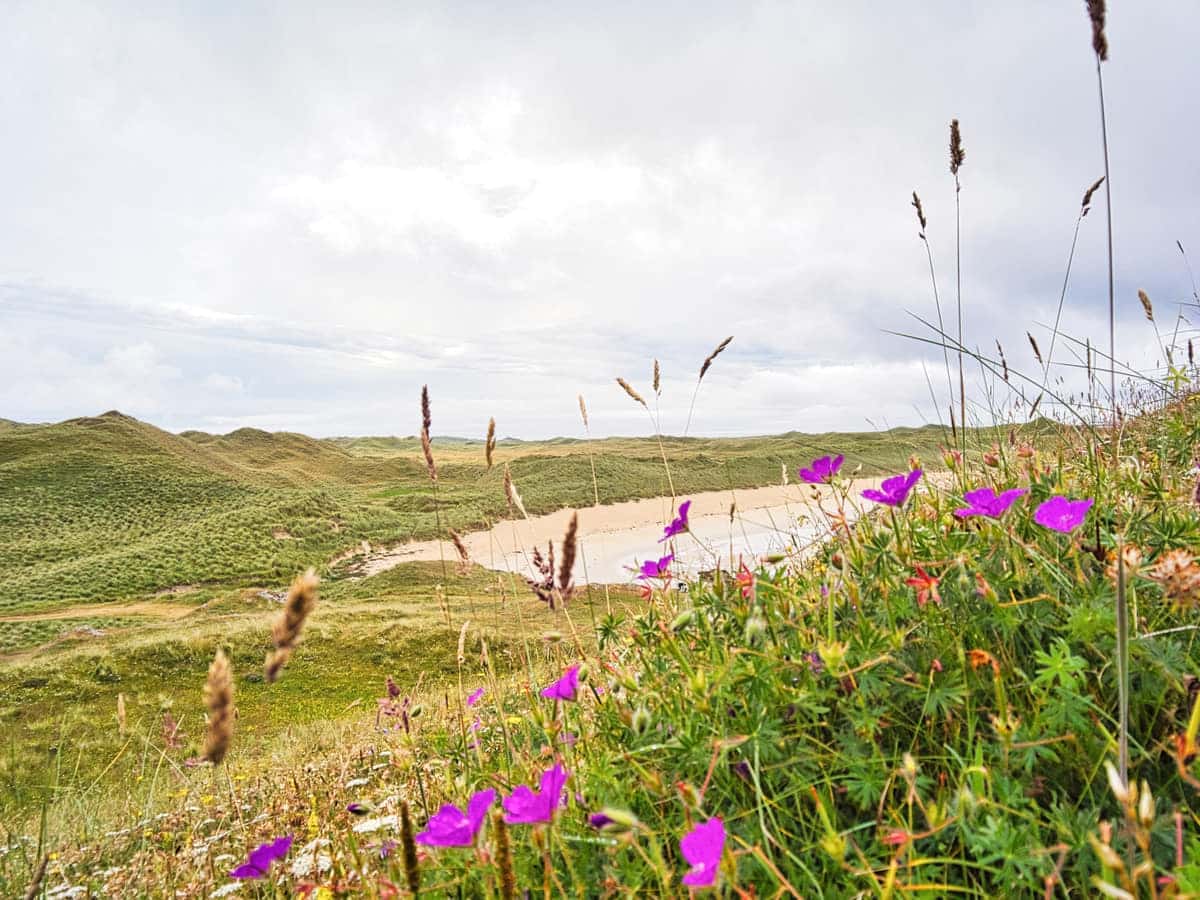
Tourist Information
As far as highlights go, I would have to say the beaches are the best feature of Coll as they’re all very secluded and entirely free of tourism. There are over thirty golden sand beaches on the island but only around twenty are of a size worth visiting, with the largest located to the south. Of the beaches I saw, I’d place Crossapol and Feall at the top of the list, along with Cliad in third place, but to be honest, they’re all drop-dead gorgeous.
The only negative is the fact that unlike Tiree where you can easily walk to most beaches from the roadside, Coll’s beaches are much more difficult to get to and the majority are well off the beaten track, meaning you’ll have to park up and walk a fair distance to get to them.
That being said, if you’re just looking for the easiest access I suggest heading to Crossapol as there’s a designated grass parking area courtesy of the RSPB and it’s only a five to ten-minute walk across the dunes till you reach the sea. Speaking of the RSPB, if you enjoy watching wildlife, you should definitely head to the RSPB Coll Nature Reserve at Totronald, as not only is the area incredibly scenic, but it’s an absolute haven for birds.
Expect to see barnacle geese, lapwings, and redshanks as you walk around this western corner of the island and keep your ears open for the elusive corncrake which is usually heard well before it’s seen.
Meanwhile, looking offshore, there’s a good chance to watch puffins, basking sharks, and otters, while the inland machair offers a safe habitat for waders. It’s a very, very pretty area that’s teeming with critters of all descriptions, so packing a pair of binoculars in your backpack is an absolute must.
If you prefer getting active you’ll find plenty of activities to keep you occupied on Coll thanks to roads and tracks that are begging to be cycled and walked as well as a coastline that offers lots of water sports opportunities.
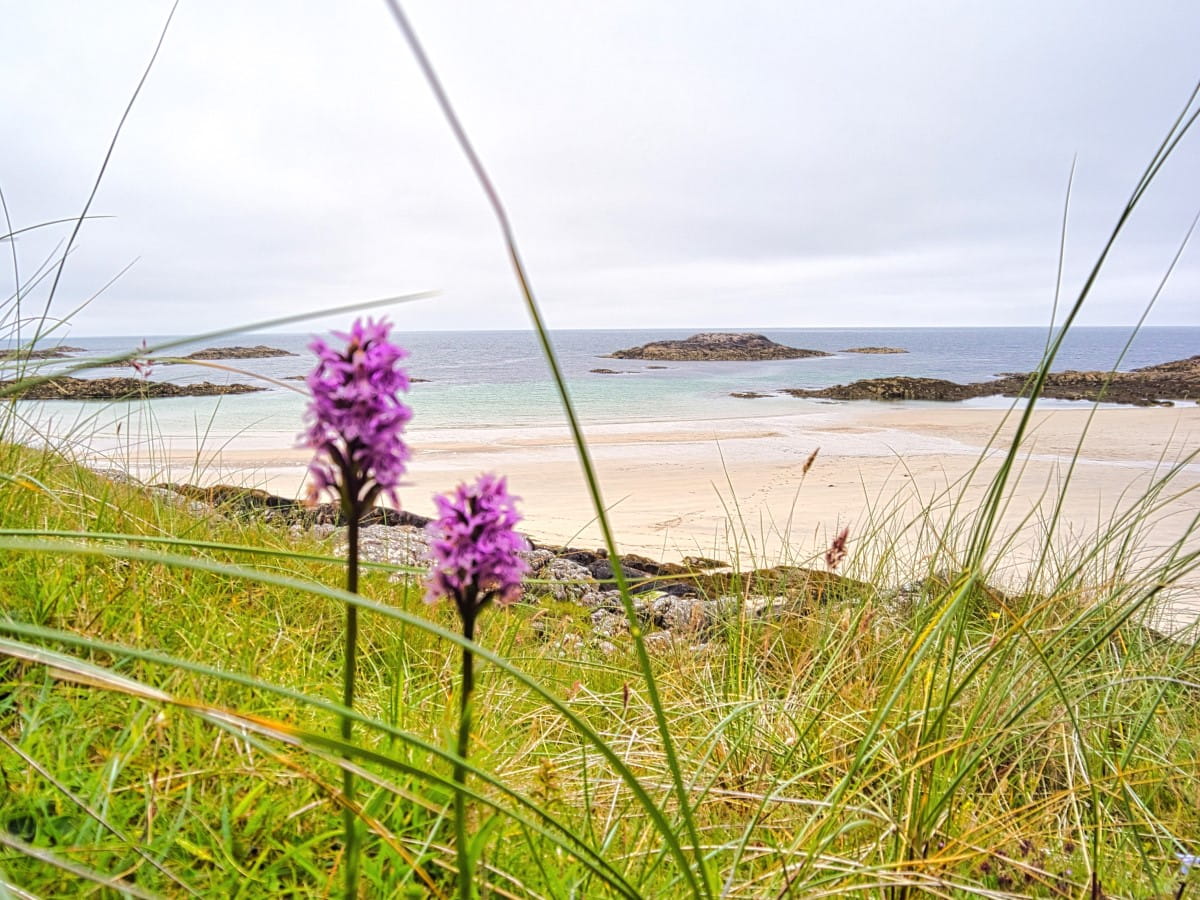
Due to the North Atlantic Gulf Stream, the waters around Coll are quite warm and the swell is just as impressive as neighbouring Tiree which makes the island a great destination for surfers. It’s also a fantastic island to paddle around in a sea kayak as there are lots of sheltered bays that offer shelter from the Inner Hebride’s famously strong winds.
Most of these secluded bays are perfect for overnight camping as well, so if the thought of a kayaking/camping holiday floats your boat (so to speak), give Coll some serious consideration.
Elsewhere on the island, you’ll find a number of crannogs (ancient artificial islands) on some of the lochans, the most famous of which is the thirty-metre-square Dun Anlaimh on Loch nan Cinneacha. This is believed to date from the Middle Ages, but some historians suggest it’s even older than that, so if you like exploring Scotland’s history, it could be an interesting addition to your sightseeing itinerary.
One final must-see I have to mention about Coll is the fact that it’s one of only two dark-sky islands in Britain. That means there’s hardly any light pollution on it (especially on the northern edge) so it’s a wonderful place to go stargazing. If you’ve never seen the stars without street lights obscuring them, Coll is a great place to go because there is nothing quite like looking up at a clear sky and seeing countless pinpricks of light twinkling away.
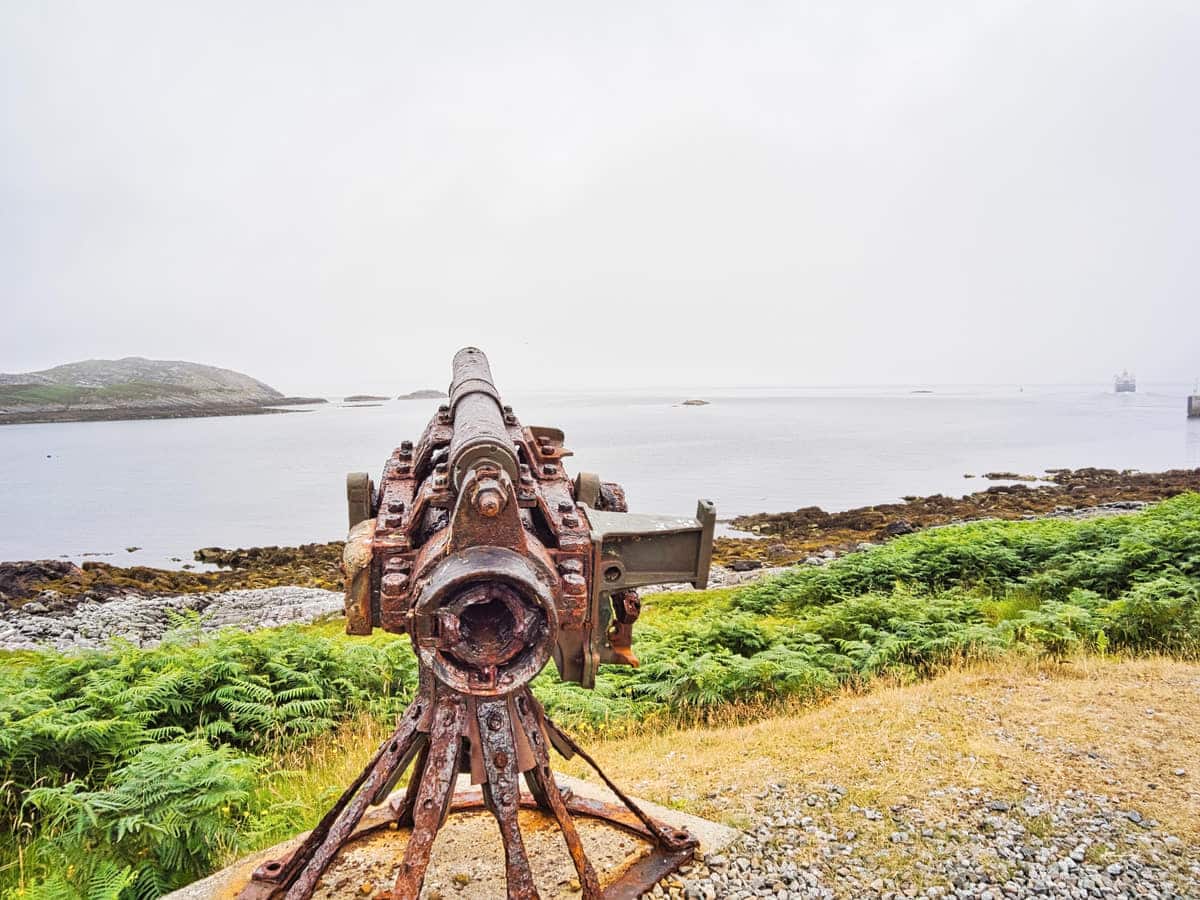
Things to Do
See Old Breachacha Castle: This historical site is one of the stunning centrepieces of Coll. Dating back to the 15th century, the castle’s picturesque location overlooking a beach makes it a perfect spot for photography, but note that it is privately owned so visitors must keep a respectful distance.
Go Bird Watching: For nature lovers, a visit to the RSPB Coll Bird Observatory (address: An Sabhal, Totronald, PA78 6TB) is a must-do. Home to a variety of bird species, it’s a haven for birdwatching and there are lots of scenic paths that run through the machair (a rare type of grass) and sand dunes.
Relax at Feall Bay: This beautiful bay is renowned for its white sand beach and turquoise waters. It’s an idyllic spot for a relaxing day out where you can enjoy a picnic, go for a swim, or simply soak up the stunning views.
Hiking on Coll: With its diverse landscapes, Coll offers a multitude of hiking trails. Whether you’re an experienced hiker or a beginner you’re guaranteed to fall in love with the island’s natural beauty. A good walking route follows the road from Crossapol to Sorisdale on a 13-mile trail that almost completes the island from south to north.
Stargazing: The Isle of Coll is a designated Dark Sky Island (a place with virtually no light pollution), making it one of the best places in the world for stargazing. On a clear night, you can marvel at the stunning night sky and (occasionally) see the Aurora Borealis.
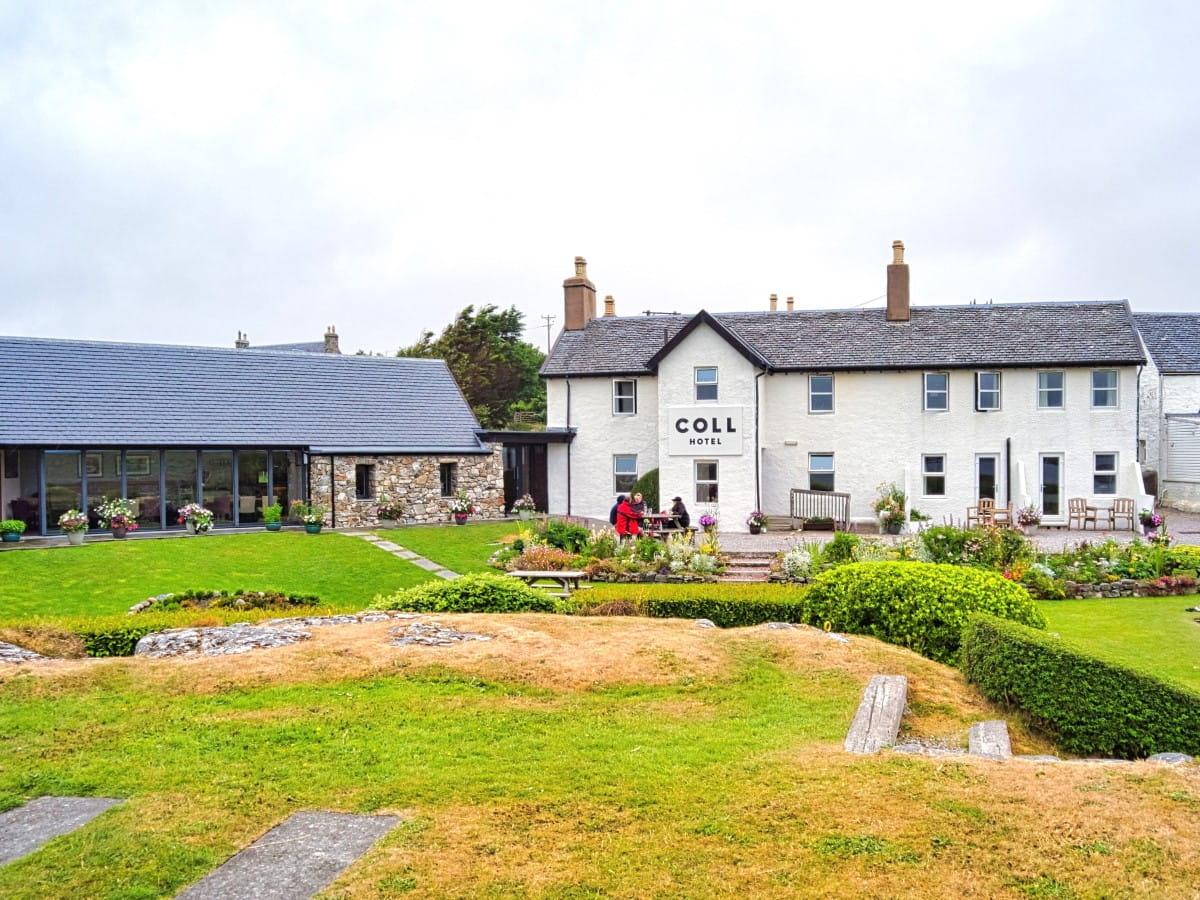
Things to Do Nearby
Food and Drink. Overnight stays on Coll wouldn’t be complete without a wee dram or three, and the Coll Hotel in Arinagour will be only too happy to serve you. The hotel is the only place on the island with a public bar and a restaurant, so if you really want to have a memorable evening I recommend phoning 01879 230334 to book a table.
If you prefer midday lunches, the Island Café in Arinagour serves locally sourced seasonal food and is licenced to serve alcohol. Telephone 018798 230022 to check the opening times.
Beaches. Coll is home to a stunning collection of beaches, most of which are rather difficult to get to. That being said, if you manage to make your way to the more remote ones, you’re almost guaranteed to have the entire place to yourself. Recommended beaches on Coll are Brechacha, Bousd, Cliad, Crossapol, Feall, Hogh, North Shore, and Red Rocks. Search Google Maps for directions.
Coll Golf Course. B8071, Isle of Coll, PA78 6TE.
Coll isn’t exactly a Mecca for golf enthusiasts but if you travel there and feel desperate to putt a few balls there’s a decent nine-hole course located on Cliad Farm, three miles from Arinagour. There are no facilities at this course but the entry fee is very reasonable. Visit the Coll Hotel and speak to the bar staff to pay the green fees.
Bird watching. RSPB Coll, An Sabhal, Isle of Coll, PA78 6TB.
There are many bird species on Coll, and some of them are quite rare in the UK. Due to the large and varied numbers of birds on the island, the RSPB has set up its own designated nature reserve where visitors can watch everything from barnacle geese and lapwings to redshanks and the (very sadly) endangered corncrake.
Cycling. If you’re visiting Coll on two wheels, you’ll find it’s a superb place for cycling thanks to the numerous single-track roads that thread their way through the wild countryside. In some places, these roads transition into rough grass tracks and sand-covered paths, so it’s best to take a sturdy mountain bike rather than a narrow-wheeled road bike.
The two main roads on Coll are the B8071 and B8072, which head to the north of the island, and the B8070, which heads to the south. All roads see little traffic and are very safe to cycle on.
Frequently Asked Questions
Who lives on the Isle of Coll?
The Isle of Coll has a permanent resident population of around 220 people, which increases substantially with tourists during the summer months. The majority of the island’s residents work in the fishing, crofting, and tourism industries.
Do you need a car on Coll?
Visitors do not need a car on Coll. It is possible to take your own car, but due to its small size (13 miles by 3 miles), the island can easily be explored on foot and bicycle.
There is no public transport on Coll and there is no taxi service. Most roads are tarmacked, but a substantial number are off-road dirt and grass tracks. All roads are single-lane with numerous passing spaces.
Which is better Coll or Tiree?
Both islands are slightly different geographically, but both offer great experiences for tourists. Whether one is ‘better’ than the other depends on personal preference.
Tiree has easier access to its beaches, and the beaches are generally larger. Tiree is also flatter and windier. Coll has more hills and is arguably better for walking, plus it has fewer tourists. Both islands are good for cycling.
What visitor facilities are there on the Isle of Coll?
The Isle of Coll has limited visitor facilities. A public bar and restaurant can be found at the Coll Hotel, and the Island Café in Arinagour is licenced. Car hire is available via Toraz. Leisure and travel boat charters are available from IsleGO sea taxis. There are some designated car parking areas (the Coll Hotel and Crossapol Beach, for example).
Is Coll worth visiting?
The Isle of Coll is definitely worth visiting. If you enjoy outdoor activities such as hiking, birdwatching, or relaxing on a beach, then the Isle of Coll will be a worthwhile destination for you. The island has a small population and a peaceful, rural atmosphere, making it a good choice for those looking to get away from the hustle and bustle of everyday life.
Where is the Isle of Coll?
The Isle of Coll is an island located in the Inner Hebrides. It is situated in the west coast waters of Scotland in the council area of Argyll and Bute, approximately 2 miles north of the Isle of Tiree and 7 miles west of the Isle of Mull.


